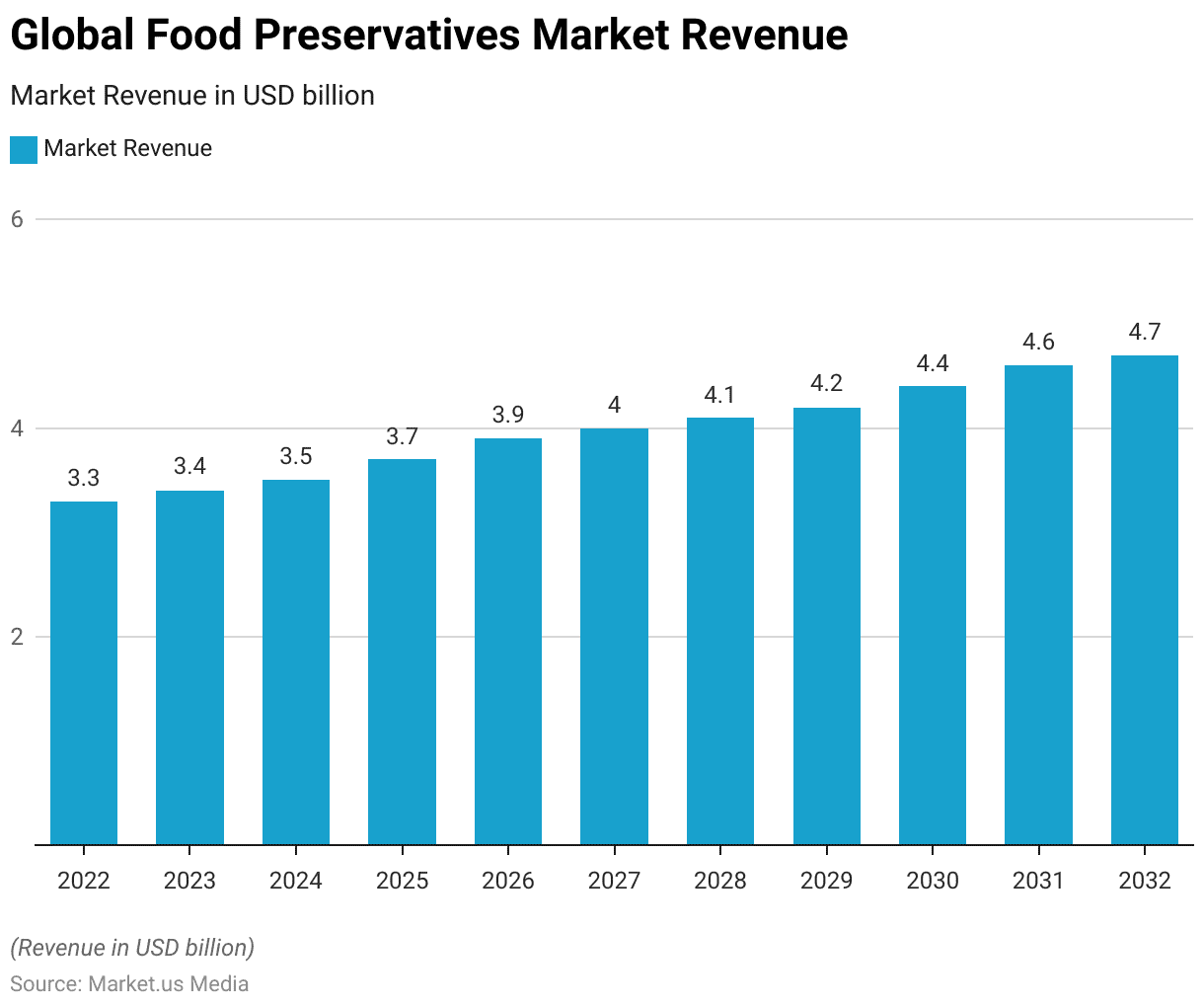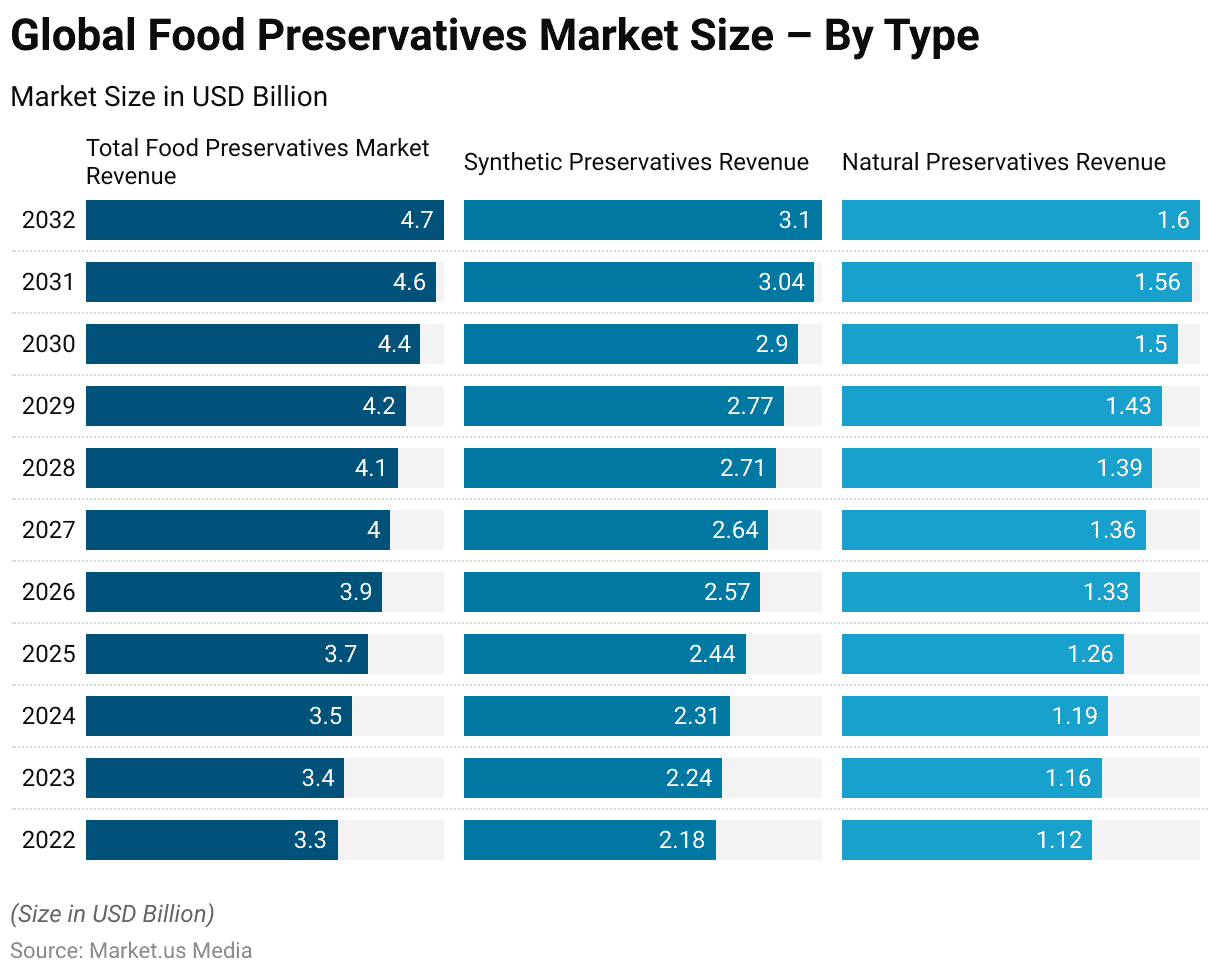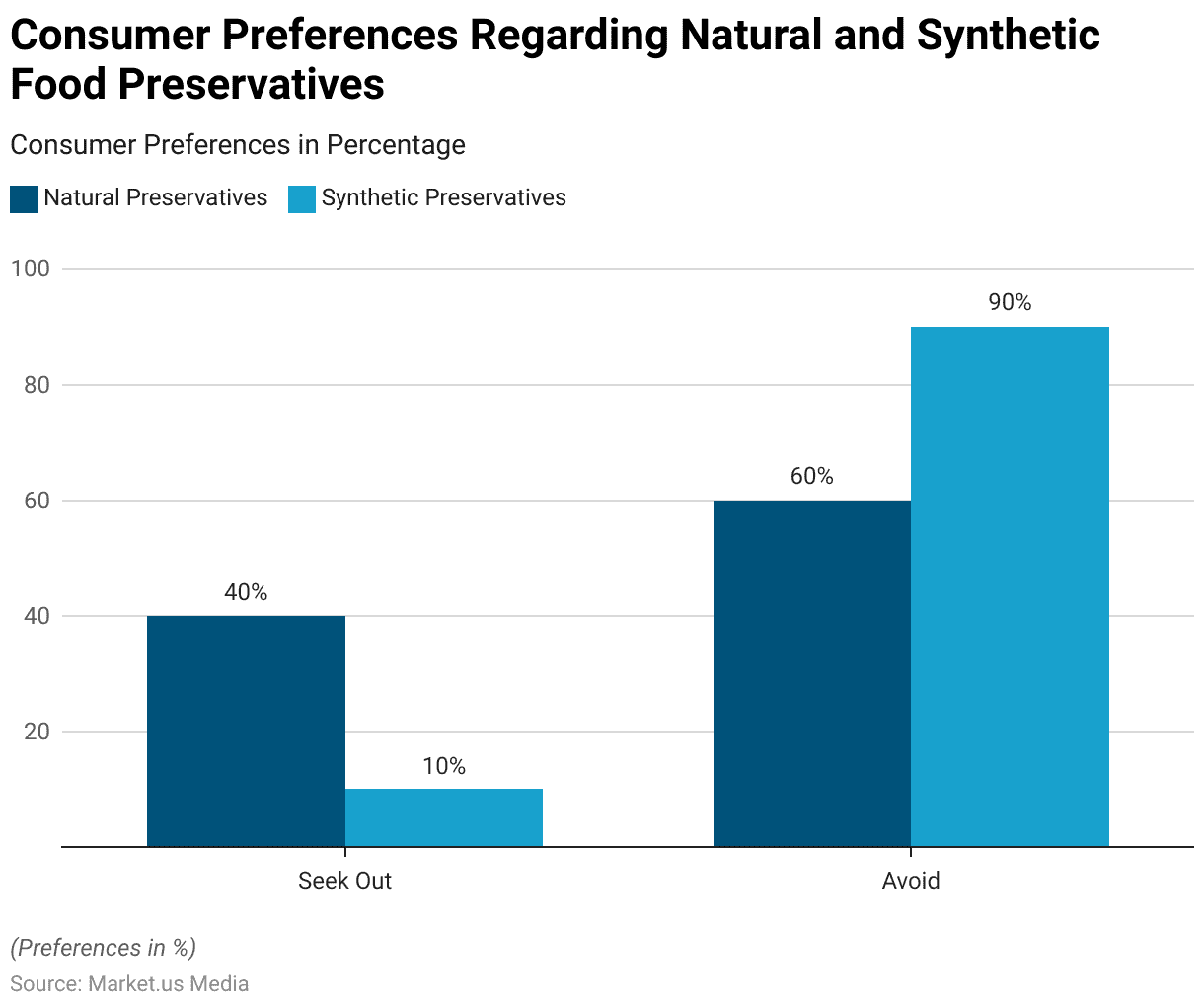Table of Contents
- Introduction
- Editor’s Choice
- Global Food Preservatives Market Overview
- History of Food Preservation
- Examples of Natural Food Preservatives
- Synthetic Food Preservatives
- Consumer Preferences Regarding Food Preservatives
- Regional Variations in Consumer Preferences Regarding Synthetic Food Preservatives
- Medical Side-effects and Challenges Associated with Food Preservatives
Introduction
According to Food Preservatives Statistics, Food preservatives are substances incorporated into food products to extend their shelf life by hindering the growth of microorganisms and averting oxidation. They are categorized into two primary groups: natural, such as salt and sugar, and synthetic, like benzoates and sulfites.
These inclusions are vital for preventing food spoilage, maintaining freshness, and ensuring compliance with safety regulations. Their utilization is overseen by governmental bodies, and they are commonly present in a broad assortment of food items, spanning from baked goods to beverages and processed meats.
Despite rising concerns regarding the potential health effects of synthetic preservatives, there is a growing consumer inclination toward natural options. However, grasping the fundamentals of food preservatives remains imperative for upholding the quality and safety of food within the industry.
Editor’s Choice
- In 2023, the global food preservatives market generated approximately USD 3.4 billion.
- Synthetic preservatives accounted for the majority of revenue through 2022-2032, with figures climbing from USD 2.18 billion in 2022 to USD 3.10 billion in 2032.
- Conventional preservatives hold the majority share, accounting for 63% of the market, while clean-label preservatives represent the remaining 37%.
- 42% of Americans believe that adding preservatives to foods aids in reducing food waste, while 21% disagree.
- According to surveys, approximately 40% of consumers actively seek out natural preservatives, appreciating their perceived health benefits and clean label appeal.
- Conversely, only 10% of respondents express a preference for synthetic preservatives, with a majority of 90% avoiding them.
- In the Asia-Pacific region, the highest share of consumers, at 67%, reported actively avoiding artificial preservatives, indicating a strong preference for natural and minimally processed foods.

Global Food Preservatives Market Overview
Global Food Preservatives Market Size
- The global food preservatives market has demonstrated a consistent upward trajectory in revenue over the past decade at a CAGR of 3.8%.
- In 2022, the market generated approximately USD 3.3 billion, marking the starting point of this growth trend.
- This growth trend persists, with anticipated revenues of USD 4.0 billion in 2027, USD 4.1 billion in 2028, and USD 4.2 billion in 2029, showcasing sustained market momentum.
- As we move into the next decade, the market is expected to further strengthen, with revenues forecasted to reach USD 4.4 billion in 2030, USD 4.6 billion in 2031, and USD 4.7 billion in 2032, underscoring the resilient nature of the global food preservatives market and its promising prospects for the future.

Food Preservatives Market Size – By Type
- The global food preservatives market, categorized by type into synthetic and natural preservatives, has exhibited consistent growth in revenue over the forecast period.
- Synthetic preservatives accounted for the majority of revenue throughout this period, with figures climbing from USD 2.18 billion in 2022 to USD 3.10 billion in 2032.
- In contrast, natural preservatives also experienced steady growth, rising from USD 1.12 billion in 2022 to USD 1.60 billion in 2032.

Food Preservatives Market Share – By Label Type
- In the global food preservatives market, the distribution of market share is divided between conventional and clean-label categories.
- Conventional preservatives hold the majority share, accounting for 63% of the market, while clean-label preservatives represent the remaining 37%.

History of Food Preservation
- In the early 1800s, amid the Napoleonic Wars, a pivotal exploration into food preservation commenced.
- This was prompted by the realization that salt-preserved meats lacked sufficient nutritional value and the alarming occurrence of scurvy among soldiers and sailors.
- French chemist Nicolas Appert made a groundbreaking discovery during this time: he found that subjecting food to heat in tightly sealed containers effectively preserved it.
- This breakthrough marked a significant advancement in food preservation techniques.
Examples of Natural Food Preservatives
Rosemary Extract
- The specified ingredients include rosemary extract, rosemary acid, and rosemary oil, with varying specifications of rosemary acid content ranging from 5% to 30% to 98%.
- These components are typically found in the form of fine brown powder.
- Known for their efficacy as food antioxidants, rosemary-derived compounds serve as natural preservatives, effectively inhibiting oxidative processes that lead to food spoilage.
Forsythia Extract
- Forsythia, an herb commonly used in traditional Chinese medicine, possesses antibacterial properties that inhibit the growth of various bacteria, making it a suitable natural preservative.
- Forsythia extract demonstrates inhibitory effects on both Gram-positive and Gram-negative bacteria, effectively prolonging the shelf life of food products.
- Its antibacterial components, primarily forsythia phenol, contribute to its efficacy in food preservation.
Garlic Extract Allicin
- Garlic, known for its allicin content, exhibits potent inhibitory and lethal effects on dysentery bacilli, certain pathogenic intestinal bacteria, and common food spoilage fungi, rendering it a natural preservative.
- While garlic’s antibacterial properties are relatively mild, its stems and leaves demonstrate significant antibacterial activity.
- However, these antibacterial properties diminish significantly at high temperatures, with the optimal temperature for garlic extract preservation being below 85°C.
Clove Oil
- Clove is rich in compounds like eugenol and tannin.
- Research indicates that clove oil possesses a wide-ranging antibacterial effect, notably against Staphylococcus aureus, Escherichia coli, yeast, and Aspergillus Niger commonly found in food.
- Remarkably, clove oil maintains its antibacterial efficacy even at high temperatures of up to 100°C.
- Its most notable characteristic is its potent antifungal properties, making it effective in inhibiting fungal growth.
Chitosan
- Chitosan, also known as chitin, is a polysaccharide derived from sources like crab, shrimp, and insects through chitin deacetylation.
- It exhibits potent inhibitory effects against bacteria such as E. coli, common Proteus, Bacillus subtilis, and Staphylococcus aureus while preserving the natural flavor of food.
- Widely utilized in pickled foods, raw noodles, rice, bean paste, seasonings, and fresh strawberries, chitosan serves as a natural preservative in various food products.
Synthetic Food Preservatives
Sulfur dioxide
- Sulfur dioxide (SO2) is effective against yeast and mold, altering cellular metabolic processes and enzymatic systems.
- Despite its advantages such as antioxidant properties and color preservation, its strong odor and corrosiveness limit its use in canning.
Sorbates
- Sorbates, including sodium sorbate and potassium sorbate, disrupt enzyme systems and are particularly useful in beverages, juices, wines, and bakery items.
Benzoic acid
- Benzoic acid and benzoates disturb enzymatic systems, primarily targeting yeasts and molds, making them suitable for high-acid foods and fruit drinks.
Parabens
- Parabens, like p-hydroxybenzoic acid, destroy cell structures and proteins, found in soft drinks, fish products, and salad dressings.
Propionic acid
- Propionic acid, effective against molds, yeasts, and some bacteria, also disrupts enzyme systems and finds application in various food products to inhibit microbial growth and extend shelf life.
Consumer Preferences Regarding Food Preservatives
- American consumers are increasingly prioritizing ingredient lists, favoring clean ingredients while steering clear of those that sound chemical.
- Additionally, opinions on preservatives vary: 42% of respondents believe that adding preservatives to foods aids in reducing food waste, while 21% disagree.
- Similarly, 39% agree that incorporating an ingredient to extend a food’s shelf life is beneficial, with 23% expressing disagreement.
- Interestingly, men were more inclined than women to strongly support these viewpoints.

Consumer Preferences Regarding Natural and Synthetic Food Preservatives
- Consumer preferences regarding natural and synthetic food preservatives vary significantly, with a notable inclination towards natural options.
- According to surveys, approximately 40% of consumers actively seek out natural preservatives, appreciating their perceived health benefits and clean label appeal.
- Conversely, only 10% of respondents express a preference for synthetic preservatives, with a majority of 90% avoiding them.

Regional Variations in Consumer Preferences Regarding Synthetic Food Preservatives
- As of 2016, consumer aversion to artificial preservatives in food products varied across different regions worldwide.
- In the Asia-Pacific region, the highest share of consumers, at 67%, reported actively avoiding artificial preservatives, indicating a strong preference for natural and minimally processed foods.
- Similarly, in Africa & the Middle East, Europe, and Latin America, significant proportions of consumers, with shares of 62%, 61%, and 54% respectively, expressed avoidance of artificial preservatives.
- In North America, slightly fewer consumers, accounting for 53%, reported avoiding artificial preservatives in their food choices.

Medical Side-effects and Challenges Associated with Food Preservatives
- Sulfites are commonly employed as preservatives in various food items, although they are notorious for triggering a range of symptoms.
- Nitrates and nitrites serve as curing agents in meat products, with few reported instances of adverse reactions such as urticaria, itching, and anaphylaxis.
- Benzoates, utilized in foods as antimicrobial preservatives, have been linked to exacerbating conditions like asthma, allergic rhinitis, chronic urticaria, and flushing in certain individuals.
- Sorbates and sorbic acid are added to foods for their antimicrobial properties, with rare instances of reactions reported, including urticaria and contact dermatitis.
Discuss your needs with our analyst
Please share your requirements with more details so our analyst can check if they can solve your problem(s)



